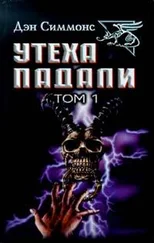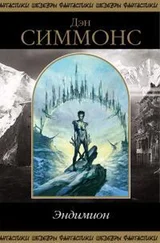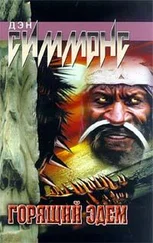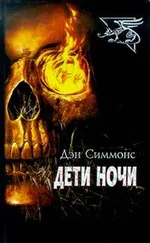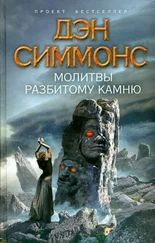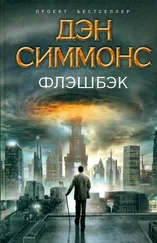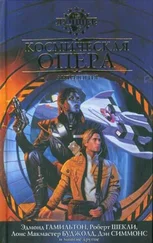Дэн Симмонс - Endymion
Здесь есть возможность читать онлайн «Дэн Симмонс - Endymion» весь текст электронной книги совершенно бесплатно (целиком полную версию без сокращений). В некоторых случаях можно слушать аудио, скачать через торрент в формате fb2 и присутствует краткое содержание. Жанр: Эпическая фантастика, Космическая фантастика, на английском языке. Описание произведения, (предисловие) а так же отзывы посетителей доступны на портале библиотеки ЛибКат.
- Название:Endymion
- Автор:
- Жанр:
- Год:неизвестен
- ISBN:нет данных
- Рейтинг книги:3 / 5. Голосов: 1
-
Избранное:Добавить в избранное
- Отзывы:
-
Ваша оценка:
- 60
- 1
- 2
- 3
- 4
- 5
Endymion: краткое содержание, описание и аннотация
Предлагаем к чтению аннотацию, описание, краткое содержание или предисловие (зависит от того, что написал сам автор книги «Endymion»). Если вы не нашли необходимую информацию о книге — напишите в комментариях, мы постараемся отыскать её.
Endymion — читать онлайн бесплатно полную книгу (весь текст) целиком
Ниже представлен текст книги, разбитый по страницам. Система сохранения места последней прочитанной страницы, позволяет с удобством читать онлайн бесплатно книгу «Endymion», без необходимости каждый раз заново искать на чём Вы остановились. Поставьте закладку, и сможете в любой момент перейти на страницу, на которой закончили чтение.
Интервал:
Закладка:
Leaving the window, I headed for the tower stairs and a look around the university and city after which my family had taken its name. However crazy the old man was, dinner conversation should be interesting.
Suddenly, when I was almost at the base of the tower stairs, I stopped in my tracks.
A. Bettik. The name was from Grandam’s telling of the Cantos. A. Bettik was the android who piloted the pilgrims’ levitation barge Benares northeast from the city of Keats on the continent of Equus, up the Hoolie River past Naiad River Station, the Karla Locks, and Doukhobor’s Copse to where the navigable river ended in Edge. From Edge the pilgrims had gone on alone across the Sea of Grass. I remembered listening as a child, wondering why A. Bettik was the only android named, and wondering what had happened to him when the pilgrims left him behind at Edge. The name had been lost to me for more than two decades.
Shaking my head slightly, wondering whether it was the old poet or I who was mad, I went out into the late-afternoon light to explore Endymion.
5
At the same moment that I am taking my leave of A. Bettik, six thousand light-years away, in a star system known only by NGC numbers and navigation coordinates, a Pax task force of three fast-attack torchships led by Father Captain Federico de Soya is destroying an orbital forest. The Ouster trees have no defenses against the Pax warships, and the encounter might be described more accurately as slaughter than battle.
I must explain something here. I am not speculating about these events: they occurred precisely as I describe them. Nor am I extrapolating or guessing in the scenes I am about to share when I tell you what Father Captain de Soya or the other principals did when there were no witnesses present. Or what they thought. Or what emotions they felt. These things are literal truth. Later, I will explain how I came to know these things… to know them without hint of distortion… but for now I ask that you accept them for what they are—the truth. The three Pax torchships drop from relativistic velocities under more than six hundred gravities of deceleration—what spacefarers for centuries have called “raspberry jam delta-v”—meaning, of course, that if the internal containment fields were to fail for a microsecond, the crews would be little more than a layer of raspberry jam on the deckplates.
The containment fields do not fail. At one AU, Father Captain de Soya brings up the orbital forest in the viewsphere. Everyone in the Combat Control Center pauses to glance at the display: several thousand of the Ouster-tailored trees, each at least half a kilometer long, move in an elaborate choreography along the plane of the ecliptic-gravity-clustered copses, braided strands, and subtly shifting patterns of trees, always moving, their leaves always turned toward the G-type sun, their long branches shifting to find the perfect alignment, their thirsty roots deep in the vaporous fog of moisture and nutrients provided by the shepherd comets moving among the forest clusters like giant dirty snowballs. Flitting between the branches of these trees and between the trees themselves, Ouster variants are visible-humanoid shapes with silver-reflective skin and micron-thin butterfly wings extending hundreds of meters. These wings catch the sunlight from moment to moment as they open and blink like brilliant Christmas lights within the green foliage of the orbital forest.
“Fire!” says Father Captain Federico de Soya.
At two-thirds AU, the three torchships of Pax Task Force MAGI open up with their long-distance weapons. At that distance even energy beams would seem to crawl toward their targets like lightning bugs on a black bedsheet, but the Pax ships carry hypervelocity and hyperkinetic weapons: essentially small Hawking-drive starships in their own right, some carrying plasma warheads, which are spun up to relativistic velocities in microseconds to detonate within the forest, others designed simply to drop back into real space, their mass enlarged, and to plow through the trees like cannonballs fired through wet cardboard at point-blank range. Minutes later the three torchships are within energy-beam distance, and the CPBs lance out in a thousand directions simultaneously, their beams visible because of the riot of colloidal particles now filling space like dust in an old attic.
The forest burns. Tailored bark, oh-two pods, and self-sealing leaves burst from violent decompression or are sawed through by beams and shaped plasma blast-tendrils, and the escaping globules of oxygen fuel the fires amid the vacuum until the air freezes or burns away. And the forest burns. Tens of millions of leaves fly away from the exploding forest, each leaf or cluster of leaves its own blazing pyre, while trunks and branches burn against the black background of space. The shepherd comets are struck and then volatilize in an instant, blasting the braided strands of forest apart in expanding shock waves of steam and molten rock fragments. Space-tailored Ousters—“Lucifer’s angels” as the Pax forces have contemptuously called them for centuries—are caught in the explosions like translucent moths in a flame. Some are simply blown apart by the plasma explosions or comet bursts. Others are caught in the path of CPBs and become hyperkinetic objects themselves before their delicate wings and organs are flung apart. Some attempt to flee, expanding their solar wings to the maximum in a vain attempt to outrun the carnage.
None survive.
The encounter takes less than five minutes. When it is done, the MAGI task force decelerates through the forest at a diminished thirty gravities, the fusion-flame tails of the torchships igniting any tree fragments that have escaped the initial attack. Where the forest had floated in space five minutes before—green leaves catching the sunlight, roots drinking the spheres of comet-water, Ouster angels floating like radiant gossamers among the branches—now there is only a torus of smoke and expanding debris filling the plane of the ecliptic along this arc of space.
“Any survivors?” asks Father Captain de Soya, standing along the edge of the C3 central display, his hands clasped behind his back, balancing easily, with only the balls of his feet touching the sticktight strip around the display rim. Despite the fact that the torchship is still decelerating under thirty gravities, the Combat Control Center is held at a constant one-fiftieth standard-g microgravity. The dozen officers in the room sit and stand with their heads toward the center of the sphere. De Soya is a short man in his midthirties, standard. His face is round, the skin dark, and friends had noticed over the years that his eyes reflected priestly compassion more frequently than military ruthlessness. They are troubled now.
“No survivors,” says Mother Commander Stone, de Soya’s executive officer and another Jesuit. She turns from the tactical display to shunt into a blinking com unit.
De Soya knows that none of his officers in the C3 are pleased by this engagement. Destroying Ouster orbital forests is part of their mission—the seemingly innocuous trees serve as refueling and refitting centers for combat Swarms—but few Pax warriors take pleasure in wanton destruction. They were trained as knights of the Church, defenders of the Pax, not as destroyers of beauty or murderers of unarmed life-forms, even if those life-forms were tailored Ousters who had surrendered their souls.
“Lay in the usual search pattern,” de Soya orders. “Tell the crew to stand down from battle stations.” On a modern torchship the crew consists of only these dozen officers and half a dozen others spread throughout the ship.
Suddenly Mother Commander Stone interrupts. “Sir, a Hawking-drive distortion reading up-angle seventy-two, coordinates two-twenty-nine, forty-three, one-oh-five. C-plus exit point at seven-oh-oh-point-five-thousand klicks. Probability of single vehicle, ninety-six percent. Relative velocity unknown.”
Читать дальшеИнтервал:
Закладка:
Похожие книги на «Endymion»
Представляем Вашему вниманию похожие книги на «Endymion» списком для выбора. Мы отобрали схожую по названию и смыслу литературу в надежде предоставить читателям больше вариантов отыскать новые, интересные, ещё непрочитанные произведения.
Обсуждение, отзывы о книге «Endymion» и просто собственные мнения читателей. Оставьте ваши комментарии, напишите, что Вы думаете о произведении, его смысле или главных героях. Укажите что конкретно понравилось, а что нет, и почему Вы так считаете.

